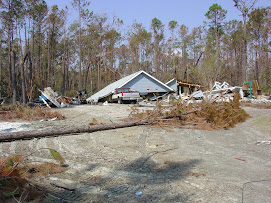If you missed Sop’s post last Friday, scroll down and take a look and look at the pictures he took after Katrina. Pay particular attention to picture number three. Note his question - How is it that the majority of the houses on this street stood while three houses in close proximity of one another were reduced to rubble?- and his answer – a tornado or mini-tornado – evidenced by the damage to nearby trees.
Some claim there were no tornadoes documented in Katrina as the storm hit and passed over the coastal counties.
Could this be a case where there are two sides of the story and both are true? Let’s visit the
Hurricanes initiate from an area of thunderstorms. Once these thunderstorms become a hurricane, an “eye” is located near the center and surrounded by an “eye wall” containing the most damaging wind and intense rain. Tornadoes [are] found within the eye wall and in the spiral bands outside.
However, a tornado’s circulation is present on the ground either as a funnel–shaped cloud or a swirling cloud of dust and debris. In other words, evidence of a tornado will be a damaged area somewhat circular in shape.
The damage Sop pointed out was linear. Nonetheless, it was very real and distinctly different from other wind damage – exactly the type of damage caused by what is called a plough wind.
Plough winds belong to a family of strong, straight-line downburst winds found in thunderstorms. When they strike the ground the air spreads horizontally in a burst of wind, much like water pouring from a tap and striking the sink below.
Plough winds can blow continuously but the damage is usually confined to an area less than 3 km [or approximately 2 miles] across. They are more common than tornadoes and have the power of a twister but the damage pattern looks different - a starburst or more commonly a straight line.
How could the linear pattern of damage in Sop’s picture be the result of anything other than plough winds from the thunderstorms that formed hurricane Katrina?
Ask Sop who paid. "I personally know of at least one such resident who was only paid on their flood policy instead of their private wind policy. That's right ladies and gents, the bill was on you, the taxpayers."

No comments:
Post a Comment